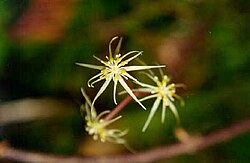| Coptis occidentalis | |
|---|---|
 | |
| Scientific classification | |
| Kingdom: | Plantae |
| Clade: | Tracheophytes |
| Clade: | Angiosperms |
| Clade: | Eudicots |
| Order: | Ranunculales |
| Family: | Ranunculaceae |
| Genus: | Coptis |
| Species: | C. occidentalis |
| Binomial name | |
| Coptis occidentalis (Nutt.) Torr. & A.Gray | |
Coptis occidentalis, the Idaho goldthread, is a species of flowering plant native to western North America. It is a member of the buttercup family. This plant has also been known under the binomial Chrysocoptis occidentalis and the common name western goldthread. [1]
The Idaho goldthread is a spring flowering plant, usually found in moist coniferous forests. [1]